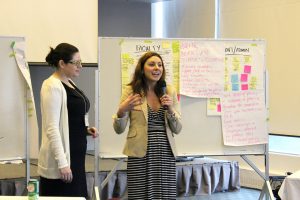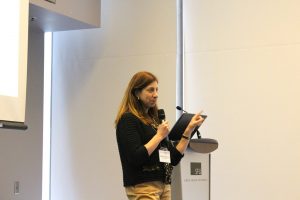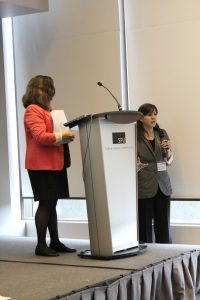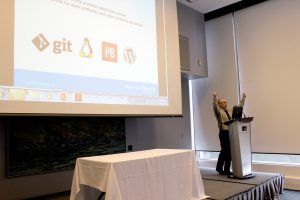It has been a fantastic year for Open Textbooks. Case in point: last year we had 30 people at the Open Textbooks Summit. This year we had 130. Key themes picked up this year were: sharing is what Open Textbooks and OER are all about, and no one has to do it alone.

We live-streamed and live-blogged the first day of the two-day conference because that’s when all the presentations and keynotes happened. The second day was given over to participants in small group sessions, so they could come up with some action items and possible workflows to take back to their institutions and start their own Open Textbooks projects.
Through it all, several lessons emerged.
1. “Librarians like to search for things. Real people like to FIND them.” – Librarians have a crucial role to play.
Once upon a time there was a librarian (Quill West) in Walla Walla, WA who went to a conference. At that conference was a session on copyright. Because she was new, she had no idea who the people in the room were, and sat at the front doodling in her notebook. The speaker, Cable Green from Creative Commons, saw her doodles and used them at the beginning of his talk. “Did you know that these doodles are copyrighted?” he asked.
That was her introduction to OER and open licensing. She became intrigued, and wanted to bring OER to the institution where she worked. She started making “tiny inroads.” She searched the repositories that she knew; she was looking for a community.
She noticed that reserved textbooks in her library were in huge rotation – students obviously weren’t buying their textbooks. Open Textbooks were the answer. She asked: what can we do as a college to make it easier for faculty to adopt open textbooks? We need support for faculty in their choices – to give faculty time and money to do this work.
So this librarian now works on an OER pilot project focussed on 10 most-enrolled courses in Washington. She found her community. Now she gets to work with OER full-time.
2. “It’s all about the students” – Students have more of an impact than they might think.

Ethan Senack from the Student Public Interest Research Group told the Summit how the Student PIRG has done a mix of old school and new media advertising to raise awareness and put pressure on their institutions and elected officials to use more open resources (see #textbookbroke hashtag on Twitter). Students have offered their strengths in building an OER movement: they are a volunteer “army” on the ground.
Nicole Allen, the OER Program Director at SPARC (The Scholarly Publishing and Academic Resources Coalition), said that when students speak, people listen, because, after all, the higher ed system exists because of students. At University of Maryland, student activists were instrumental in getting an OER program – and the pressure from students in Saskatchewan and Alberta led to those governments signing a MOU with British Columbia to join forces and use Open Textbooks more widely. They also advised students to seek out support where needed: librarians, faculty groups, and administrators.
3. “The ideal textbook does not exist” – Open Textbooks means control is given back to instructors

Barbara Illowksy co-authored the “Collaborative Statistics” and “Introductory Statistics” textbook. “Writing a textbook was the last thing I ever expected to be doing,” she told the Summit.
In the early 90s she was looking for a text that would incorporate technology into teaching and learning, and included multicultural activities. She wanted to use a collaborative learning pedagogical approach focused on understanding concepts, not solving for variables, as most other statistics textbooks did. She needed the materials to be more relevant to her students’ real world experiences.
Seeing as the kind of statistics textbook she wanted to use didn’t exist, she had to write it herself. She detailed process she went through, and her lessons learned, at the summit (chief of which is “develop a thick skin.”
In Takashi Sato’s ideal world, he’d pick a textbook that matched his course content and teaching style, he’d use it, students would use it – done! All the resources would be packaged up for him. But that’s not the real world. In the real world, edition changes to traditional textbooks are annoying and require effort.
However, with OER: he can make edits that are a closer match to his course’s needs; he has control over the revisions and edition changes, and he and the students are always looking at the same copy of the materials.
4. “OER is like being given a puppy” – Taking control of educational content takes commitment.

Much of the disussion around Open Textbooks pointed to the work required to keep OER current and relevant. One of the participants at the “faculty” small group discussion pointed out that being given an open resource is like being given a puppy: yes, it’s adorable, but it needs care and feeding in order to thrive.
Kate Cotie from the B.C. Ministry of Advanced Education said: “One of the big challenges we face is sustainability. We want to grow OER into something that is mainstream.”
Diane Salter-Menzo, KPU Vice Provost Teaching and Learning, pointed out that OER and Open Textbooks take time: time to research. modify, adopt and think about how to use them in courses. It will take institution-wide policy and resources to:
- Support library to have the resources to support faculty
- Give opportunities to learn and demystify the OER process
- Support faculty in finding the resources and use them
She pointed out most of funding mechanisms for this support have been at the faculty level (for instance BCcampus funding is for individual reviewers, adapters, and creators), but we need process and policy for sustaining at a scaled-up level.
Ms Salter-Menzo as well as Minister Amrik Virk (in his opening remarks) asked: How do we motivate institutions to use OER more?
All at the summit agreed that forcing the use of OER by edict or legislation might be a bad idea, and academic freedom is paramount. There are other ways to support greater use of OER. How do we make policy using government funding for institutions? Should funding from government be linked to institutional strategic directions towards OER?
5. “Come on in, the water’s warm!” – We need a bigger developer community around the technology of open source publishing.

Brad Payne and Clint Lalonde of BCcampus went through some of the technology challenges in publishing Open Textbooks.
Clint explained why BCcampus uses Pressbooks: it’s open source, it’s built on the popular WordPress content management system, it’s well used and well supported, and something faculty are probably familiar with already.
With Pressbooks we can enter content once and push it out in various formats: PDF, EPub, and others. BCcampus also partnered with SFU document solutions to offer the print on demand service, which is also a WordPress site.
Brad Payne listed some of the contributions he’s made to WordPress and PressBooks code and issued an invitation for developers to “Come on in!”
The modifications I made were only made possible with open licensing,” he said. “If you can do it better, grab a developer or a content creator and change it!”
Further reading:
- Open Textbook Summit web site – including the live blog entries created that day.
- OpenEd – all things OER at BCcampus, including our Open Textbooks.
Notable quotes:
“It wasn’t difficult to get people to adopt open resources. It was a matter of saying “I’m here to help you.” People LOVE librarians and they want to work with us!” – Quill West
“Nobody goes into their sock drawer using probability to match socks. I needed a more relevant learning context for my students. I needed a way for them to assess claims like ‘4 out of 5 dentists recommend x brand,’ or if you have to take a drug test or a medical test and you test ‘positive’ – what does that actually mean? It doesn’t mean you actually took drugs or have HIV, it’s about probability, we need ways to assess those measures, those claims.” – Barbara Illowksy, Professor of Mathematics and Statistics, DeAnza College, California
“I’m a statistician. Even in silicone valley, I like to say ‘I’m a teacher,’ because you get invited back to parties. But when you say ‘I’m a statistician,’ the conversation ends. Now I get to say ‘I’m part of a cult!’ ‘Wow, what’s the cult?’ is the reply. See? It’s more interesting!” – Barbara Illowsky, referring to the OER community (in a good way) as the “cult.”
“We had always shared educational resources at KPU. I didn’t know these resources had a name (OER) – we just always said ‘Feel free to steal my stuff.’ We are good at sharing, but it wasn’t always well organized, and not many were developed into textbook form.” – Takashi Sato, Physics Instructor, Kwantlen Polytechnic University
“Increasing access means enhancing the learning experience. We have to do more, do it better, and do it for less money. We CAN do this, but we have to do it together.” – Diane Salter-Menzo, Vice-Provost for Teaching and Learning, Kwantlen Polytechnic University
“Students are the experts on what they experience, so involve them at every level and listen to what they have to say. Students may not be the experts on the details, but think of how you can inform, guide and support them. Figure out what process they can go through to effect change on campus, in the legislature.” – Nicole Allen, SPARC
“The modifications I made were only made possible with open licensing. If you can do it better, grab a developer or a content creator and change it!” – Brad Payne, developer, BCcampus
